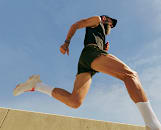
Gratsias Adhi Hermawan / iStock / Getty Images Plus via Getty Images
How to Prevent Side Stitches from Ruining Your Workout
Learn how to get rid of side stitches so you can keep moving, pain-free.
By Jennifer Heimlich, Team Peloton•
What Is a Side Stitch?
What Causes a Side Stitch?
Common Exercises That Trigger Side Stitches
How to Get Rid of Side Stitch While Exercising
How to Prevent a Side Stitch
When to Speak with Your Doctor About Side Stitches
The Takeaway
Let’s set the stage: You’re in the middle of a highly effective workout, feeling absolutely in the zone, when all of a sudden you’re hit with a sharp pain in your side, just below the rib cage. At first, you think you can handle it, but the side stitch becomes hard to ignore, throwing off your workout and causing the kind of acute discomfort that would make your abdomen scream if it could.
Discover more ways to reach your goals with Peloton
Sound familiar? While side stitches are a fairly common occurrence during exercises like running, that doesn’t make them any easier to manage. The pain can be (temporarily) debilitating and has the power to derail your entire workout.
If you want to reduce the risk of these pesky pains ruining future workouts, here’s what you need to know about side stitches, including what to do when you suddenly get sideswiped with one, and advice on how to prevent side stitches in the first place.
What Is a Side Stitch?
The medical term for a side stitch is exercise-related transient abdominal pain, or ETAP. According to research published in the journal Sports Medicine, this localized pain typically hits along the sides of our trunk, but it can pop up anywhere in our abdomen. While they can be terribly uncomfortable in the moment (the pain can often feel sharp or stabbing, though sometimes it’s more of an aching or pulling), side stitches generally aren’t harmful long-term.
It is also worth noting that this pain is specifically brought on by physical activity. If you experience what seems like a side stitch while you are inactive, it's likely something else entirely, like a cramp or indigestion. If you’re concerned about what feels like a cramp in your side that occurs even when you’re not exercising or that persists after you stop your activity, seek medical care.
What Causes a Side Stitch?
There are a number of different theories as to what causes side stitches. Some experts believe they’re triggered by stress or pressure on the diaphragm during rapid, labored breathing. “Either shallow breathing or really deep breathing starts to strain the diaphragm—a big muscle that lives right in our chest, where you get the side stitches,” says Chris Heydrick, a physical therapist with MedStar Health. “The diaphragm can become fatigued if it's either working really hard or working in a way that it's not used to.” One longtime hypothesis was that our diaphragm simply didn’t get enough blood flow, though exercise scientists now find that unlikely.
But there are also other possible explanations. Some attribute side stitches to ligament strain. Others point to nerve compression or increased blood flow to the liver and spleen. A current leading theory is that it’s caused by irritation of the membrane that lines our abdominal and pelvic walls. More and more, Heydrick says, exercise scientists are also looking at electrolyte imbalances as a possible culprit. “You see that a little bit more commonly [with] cramps in your legs,” he says. “But it's absolutely still something to consider with the side stitches.”
Does Dehydration Cause Side Stitches?
For years, a common gym myth was that dehydration led to side stitches. But there’s not actually enough scientific evidence to back up that idea. However, there is a chance that electrolyte imbalances could be a contributing factor, so it’s still worth paying attention to what you’re drinking.
Common Exercises That Trigger Side Stitches
Swimming and running are likely the biggest triggers of side stitches. Studies have shown that approximately 70 percent of runners have had one in the past year. What’s more, at any given running event, about one in five runners will be hit with a side stitch. Of course, this affects all kinds of athletes, since many sports involve running, such as soccer, football, basketball, lacrosse, and more.
But you don’t need to run to get side stitches. These annoying cramps also affect swimmers, horseback riders, and even cyclists. Really, they can be brought on by any type of aerobic activity that strains the torso, since they appear to be related to activities that require repetitive torso movements.

How to Get Rid of Side Stitch While Exercising
Once the dreaded side stitch pain occurs, here are some things you can do to get rid of it and recover quickly so you can get back to your workout ASAP.
Slow Down or Take a Break
Take a moment to slow down or stop, breathe, and collect yourself instead of muscling through, which could cause even sharper pain.
Focus on Your Breathing
If there was ever a time to challenge yourself to some deep breathing, it’s during a side stitch episode. Try to slow down and keep your inhales and exhales controlled and measured. You could try box breathing and inhale deeply for four counts, hold the breath for four counts, exhale completely for four counts, and then wait four counts before inhaling again.
Stretch Your Abdominal Muscles
Some light stretching of your abdominals might help the stitch subside. Reach the arm on the opposite side of where the pain is above your head and gently lean toward the side of your stitch. Alternatively, try dropping into a gentle Cobra Pose to stretch out your core.
Massage the Stitch Away
Lightly massage the area where you are feeling the sharpest pain and lean slightly forward. Try to stay in this position and breathe steadily while counting to 30.
Stay Hydrated
While you don’t want to chug too much fluid right before a workout, it’s a good idea to make sure you hydrate during exercise with small, frequent sips. Getting dehydrated could interfere with your muscle functioning. Also remember to replace the electrolytes that you’re losing through sweat with a sports drink or electrolyte mix.
Related Articles

Beginners
Short On Time? Here's How to Squeeze In a Pre-Run Stretch In Less Than 5 Minutes

Health
Wait, Can Pickle Juice Actually Relieve Muscle Cramps During Exercise?

Health
How to Prevent Runner’s Stomach from Ruining Your Next Long Run or Race

Nutrition
Electrolytes Are About More Than Just Hydration. Here Are 5 Key Benefits to Know
How to Prevent a Side Stitch
Since there’s no clear consensus about what exactly causes a side stitch, the top prevention strategies are largely based on anecdotal evidence from athletes and coaches, discovered through trial and error. Experiment with these tips that might just help you stave off a stitch, and see which ones work best for you.
Focus on Good Posture
Poor alignment and spine issues may make you more likely to experience stitches, according to some research. “When our posture is poor, we can strain the muscles in the abdomen—they can get stretched and moved in weird ways,” Heydrick says. “The diaphragm gets a little bit of excessive load that it's not used to.”
So, make sure to pay attention to your posture, check your running form, and work on strengthening your core, which supports your spine and pelvis and is crucial for maintaining proper body alignment. One small study on runners found those with stronger trunk muscles experienced fewer side stitches.
Properly Warm up Before Exercising
Take some time to warm up your muscles before starting a hard workout. This will help get your blood flowing and prepare your body, signaling to your diaphragm that you’re about to really start using it.
Avoid Eating Right Before Exercising
Research recommends waiting a couple hours to exercise after eating a big meal, as side stitches may be worse if you work out right afterwards. High-fat and high-fiber foods take longer to digest, diverting oxygen-rich blood to your GI tract, so give yourself even longer if you have a meal that’s heavy in either. Opt for a light meal or snack to fuel your workout if you’re working out soon, and no matter what you eat, give yourself some time to digest.
Decrease the Length of Your Workout
If you’re prone to side stitches, try shorter, higher-intensity workouts to discover if it might be the endurance workouts that are causing your side pain. Mixing up your routine may help you achieve the best results.
Avoid Chugging Right Before Exercising
Make sure you hydrate properly before your physical activity, but definitely don’t chug all your fluids immediately beforehand. “When the stomach is full of fluid, you can place pressure on the diaphragm that can interfere with its movement and cause pain,” Heydrick says.
Increase Your Level of Fitness Gradually
Don’t push yourself too hard, especially if you’re just starting out with running. Ease into any new fitness routines gradually so your body has time to adjust to the new challenges. But keep at it: There’s evidence that side stitches are less common among those who are more physically fit.
When to Speak with Your Doctor About Side Stitches
When it comes to side stitches, what’s most important is that you listen to your body and try to honor any cues it might be giving you. There are a few instances where you might want to bring the problem to a medical expert.
Persistent Stitches
If you’re consistently experiencing side stitches, you can try switching up your routine and testing out a different form of exercise to see if the stitches lessen. If they persist, it’s a good idea to check in with your physician to ensure there are no underlying issues contributing to it. The same goes for chronic discomfort in your sides or abdomen.
New or Severe Pain
A stitch is never fun, but it shouldn’t cause severe pain or major discomfort, particularly not for extended periods of time. If this is something you’re experiencing, stop exercising and speak to a medical professional for appropriate guidance.
Other Symptoms
Side stitches shouldn’t be accompanied by other symptoms such as dizziness, nausea, trouble breathing, or tightness or pain in your chest. If you’re experiencing any of these, speak to your doctor or seek immediate medical attention.
The Takeaway
Side stitches (aka exercise-related transient abdominal pain) can present sharp or aching pain, often alongside your trunk, during a workout. You can manage the pain now with smart strategies like giving yourself a couple hours to digest your meals before diving into a workout, pacing yourself strategically, and working on your posture. And the next time a side stitch hits, try breathing into the pain, and giving it a little massage or stretch. Soon enough, you should be able to get back to enjoying your workout, pain-free.

Peloton App
Access thousands of classes with no equipment needed.
This content is for informational and educational purposes only and does not constitute individualized advice. It is not intended to replace professional medical evaluation, diagnosis, or treatment. Seek the advice of your physician for questions you may have regarding your health or a medical condition. If you are having a medical emergency, call your physician or 911 immediately.
Level up your inbox.
Subscribe for a weekly dose of fitness, plus the latest promos, launches, and events.
By providing your email address, you agree to receive marketing communications from Peloton.
For more about how we use your information, see our Privacy Policy.








